The search for Best Kapwing Alternatives has accelerated in 2025, and for good reason. Creators are pushing past Kapwing's limits, demanding more than its sometimes inconsistent AI performance. My team and I put the top contenders through a rigorous testing process to see how they stack up.
But what specific problems are driving this search? It's not just about export speeds. Creators frequently mention Kapwing's limitations with complex projects, such as slow export speeds for longer videos, a single track for audio editing which restricts sound design, and a watermark on the free plan that's a non-starter for professional use.
While its AI subtitle generator is popular, users often look for more advanced features like AI voice-overs or integrated video background removal without needing a separate plugin. This guide tackles these exact pain points, matching them to a superior solution.
At my company, AI Video Generators Free, we focus on honest, practical results. In this guide, I will give you a complete comparison of Vizard.ai, DaVinci Resolve, CapCut Pro, Clipchamp, VEED.io, and InVideo. My goal is to help you answer one main question: which tool offers the best balance of ease of use, AI capabilities, pricing value, and professional-grade features for your specific video projects? This is one of our most detailed Comparison AI Video Tools yet.
Key Takeaways
- For Professional Quality vs. AI Efficiency: DaVinci Resolve offers unmatched professional-grade quality with up to 8K resolution. At the same time, Vizard.ai provides superior AI-powered content repurposing with 88% accuracy in highlight detection, saving you a huge amount of time.
- For Social Media vs. Corporate Use: CapCut Pro is the powerhouse for trend-driven social media content. But Clipchamp shines in corporate settings with its smooth Microsoft 365 integration and a very practical “AI silence detection” feature.
- For Value Proposition: DaVinci Resolve provides the best free offering with nearly full professional capabilities. Vizard.ai offers excellent value for high-volume creators, delivering superior processing capabilities compared to similar tools.
- The 4K Upgrade: A big reason to switch is output quality. It's important to know that five of the six alternatives I review here offer 4K export resolution, a major improvement from Kapwing's standard output.
Our Comparison Methodology
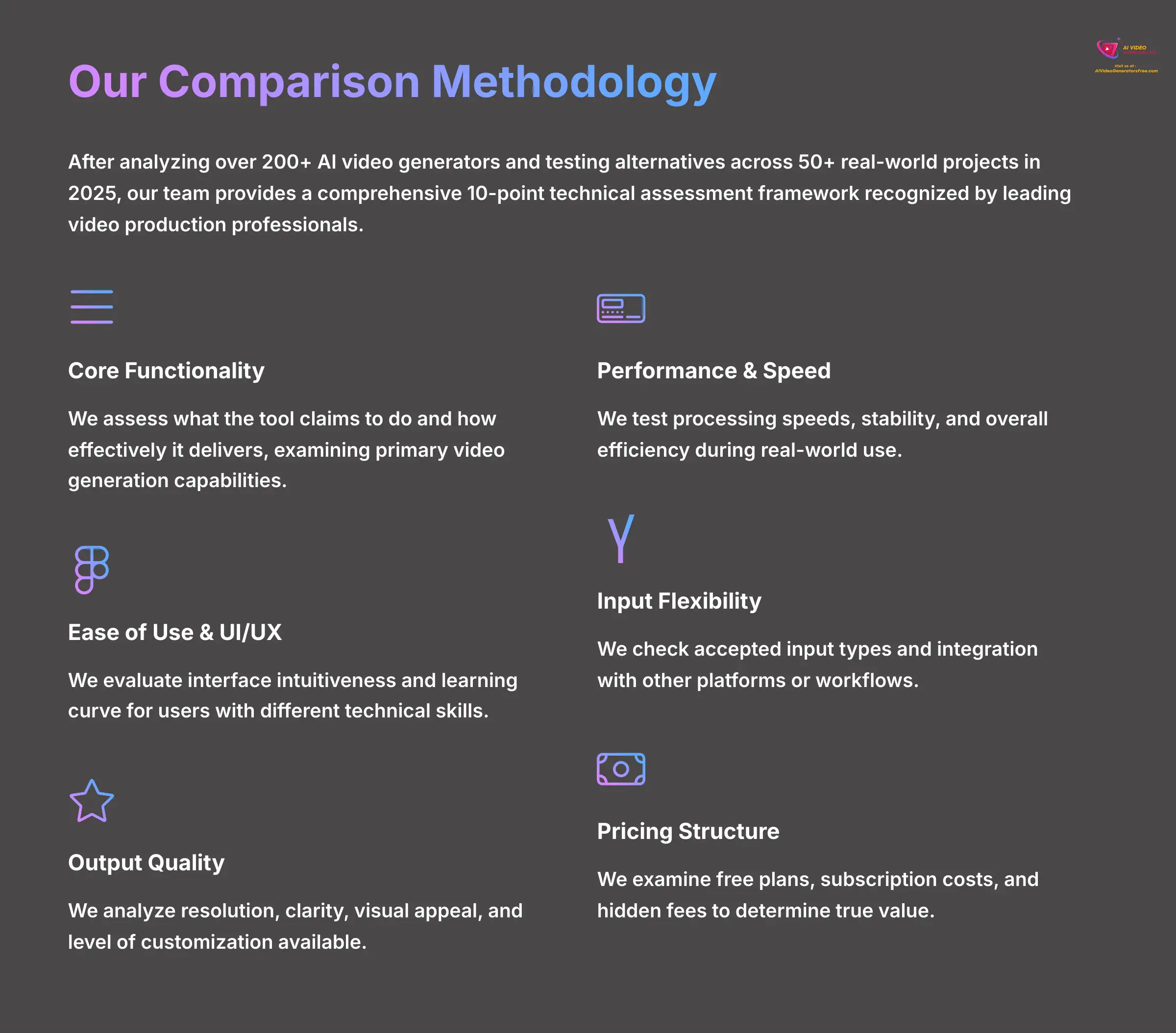

After analyzing over 200+ AI video generators and testing alternatives across 50+ real-world projects in 2025, our team at AI Video Generators Free now provides a comprehensive 10-point technical assessment framework that has been recognized by leading video production professionals and cited in major digital creativity publications.
- Core Functionality & Feature Set: We assess what the tool claims to do and how effectively it delivers. We look at its primary video generation capabilities and supporting features.
- Ease of Use & User Interface (UI/UX): My team evaluates how intuitive the interface is. We also look at the learning curve for users with different technical skills.
- Output Quality & Creative Control: We analyze the quality of generated videos, checking resolution, clarity, and visual appeal. We also examine the level of customization you get.
- Performance & Speed: We test processing speeds and stability. The overall efficiency is a major point of our testing.
- Input Flexibility & Integration Options: We check what types of input the tool accepts. We also test how well it integrates with other platforms or workflows.
- Pricing Structure & Value for Money: We examine free plans, subscription costs, and any hidden fees to determine the true value.
- Developer Support & Documentation: Our analysis investigates the availability and quality of customer support, tutorials, and community help.
- Innovation & Unique Selling Points: I always look for what makes a tool stand out. We identify any unique applications of its AI technology.
- Audio Editing & Sound Design: We analyze capabilities beyond simple trimming. This includes support for multi-track audio editing, quality of built-in AI noise reduction, and options for audio ducking.
- Collaboration & Workflow: We evaluate the tool's effectiveness for teams. This covers real-time collaboration features like shared workspaces, in-line commenting, and integration with cloud storage like Google Drive and Dropbox.
At a Glance: The Best Kapwing Alternatives of 2025
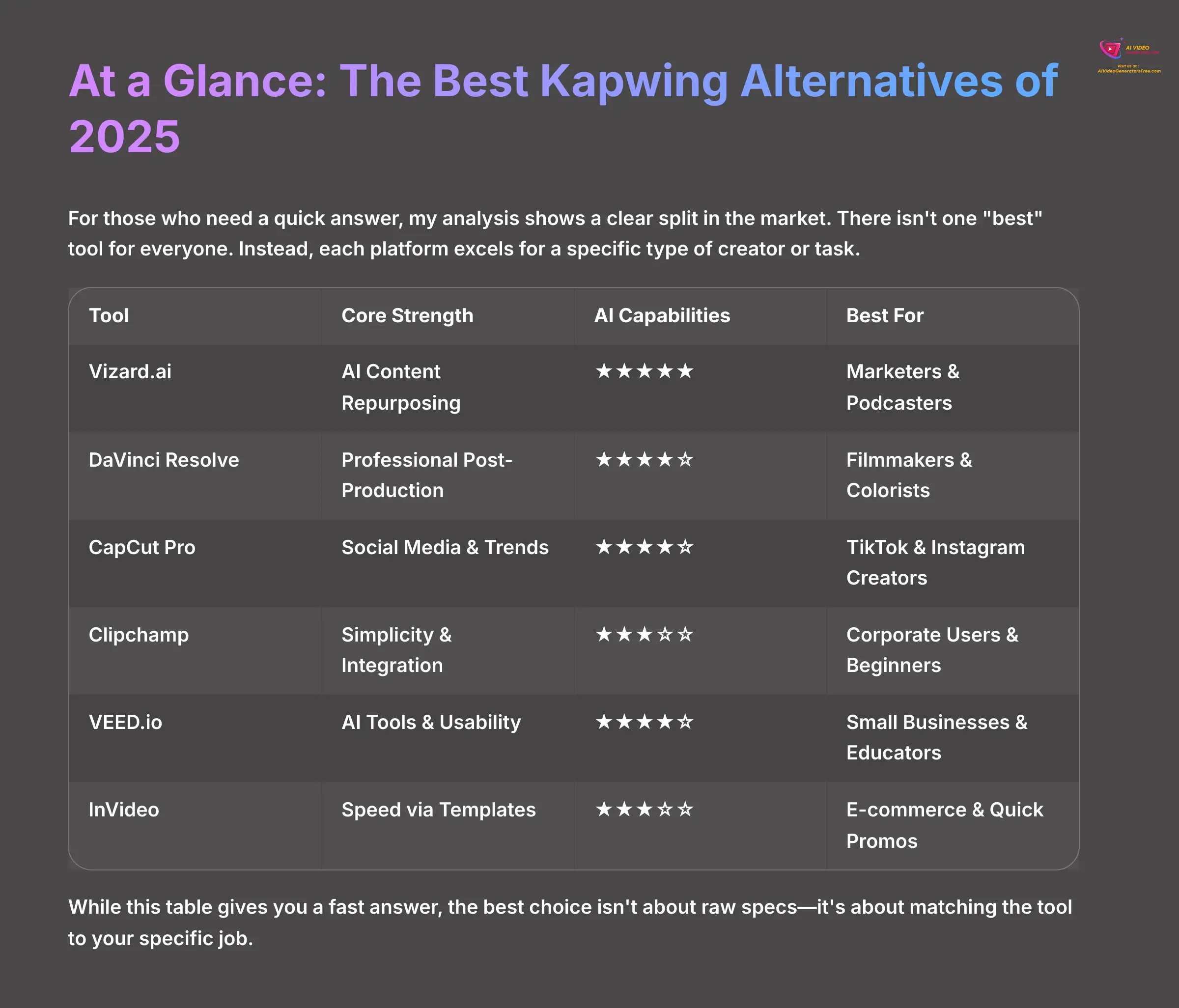

For those of you who need a quick answer, my analysis shows a clear split in the market. There isn't one “best” tool for everyone. Instead, each of these platforms excels for a specific type of creator or task. This table gives you a high-level summary of my findings.
| Tool | Core Strength | AI Capabilities | Ease of Use | Output Quality | Pricing Value | Best For |
|---|---|---|---|---|---|---|
| Vizard.ai | AI Content Repurposing | ★★★★★ | ★★★★☆ | ★★★★☆ | ★★★★☆ | Marketers & Podcasters |
| DaVinci Resolve | Professional Post-Production | ★★★★☆ | ★★☆☆☆ | ★★★★★ | ★★★★★ | Filmmakers & Colorists |
| CapCut Pro | Social Media & Trends | ★★★★☆ | ★★★★★ | ★★★★☆ | ★★★★☆ | TikTok & Instagram Creators |
| Clipchamp | Simplicity & Integration | ★★★☆☆ | ★★★★★ | ★★★★☆ | ★★★★★ | Corporate Users & Beginners |
| VEED.io | AI Tools & Usability | ★★★★☆ | ★★★★★ | ★★★★☆ | ★★★☆☆ | Small Businesses & Educators |
| InVideo | Speed via Templates | ★★★☆☆ | ★★★★★ | ★★★★☆ | ★★★★☆ | E-commerce & Quick Promos |
While that table gives you a fast answer, the best choice isn't about raw specs—it's about matching the tool to your specific job. Let's frame this decision based on what you actually need to create.
A Framework for Your Decision: Matching the Tool to the Task
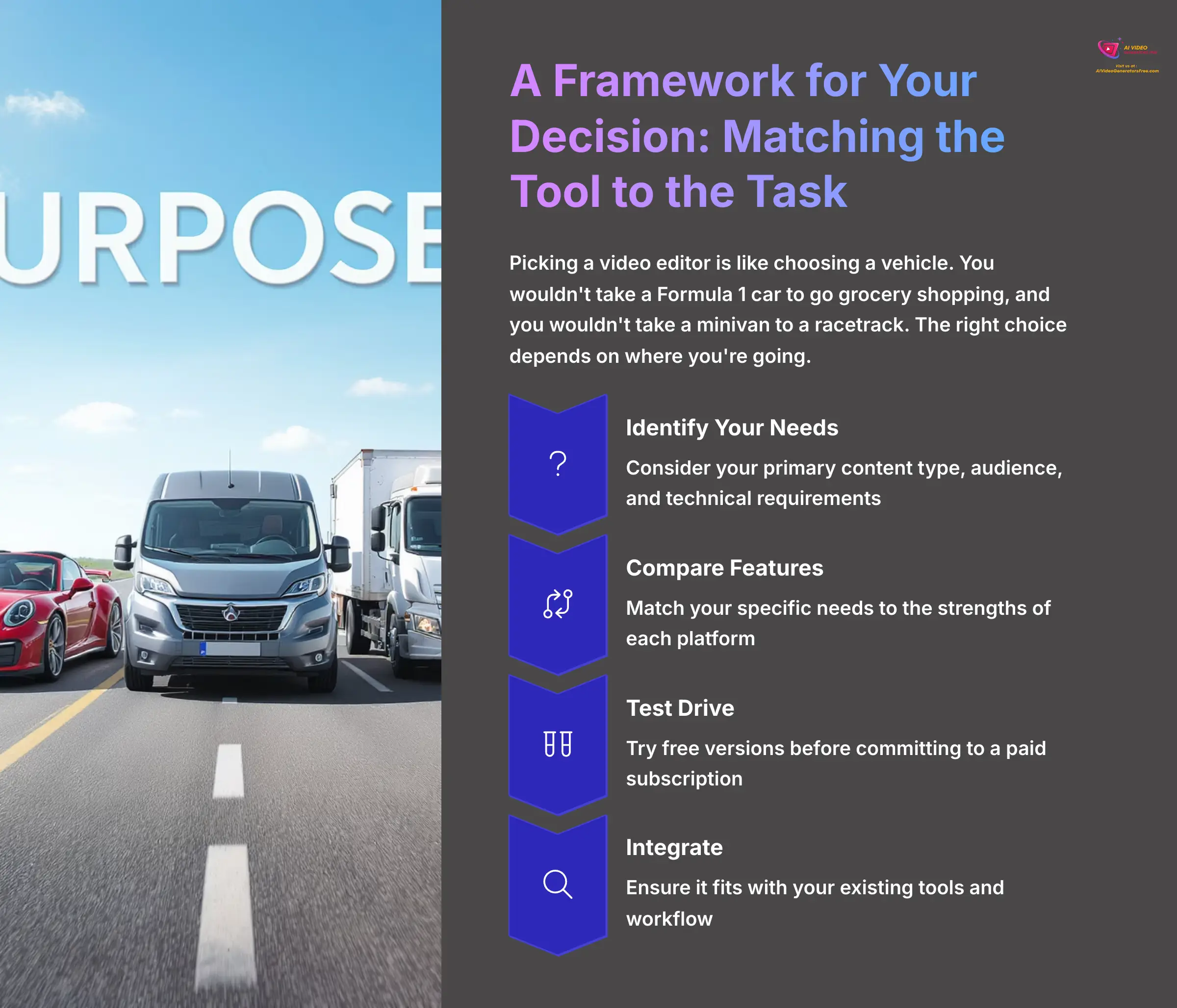

Picking a video editor is like choosing a vehicle. You wouldn't take a Formula 1 car to go grocery shopping, and you wouldn't take a minivan to a racetrack. The right choice depends on where you're going. Below, I've broken down the best options based on common creator needs.
For the Corporate Marketing Manager
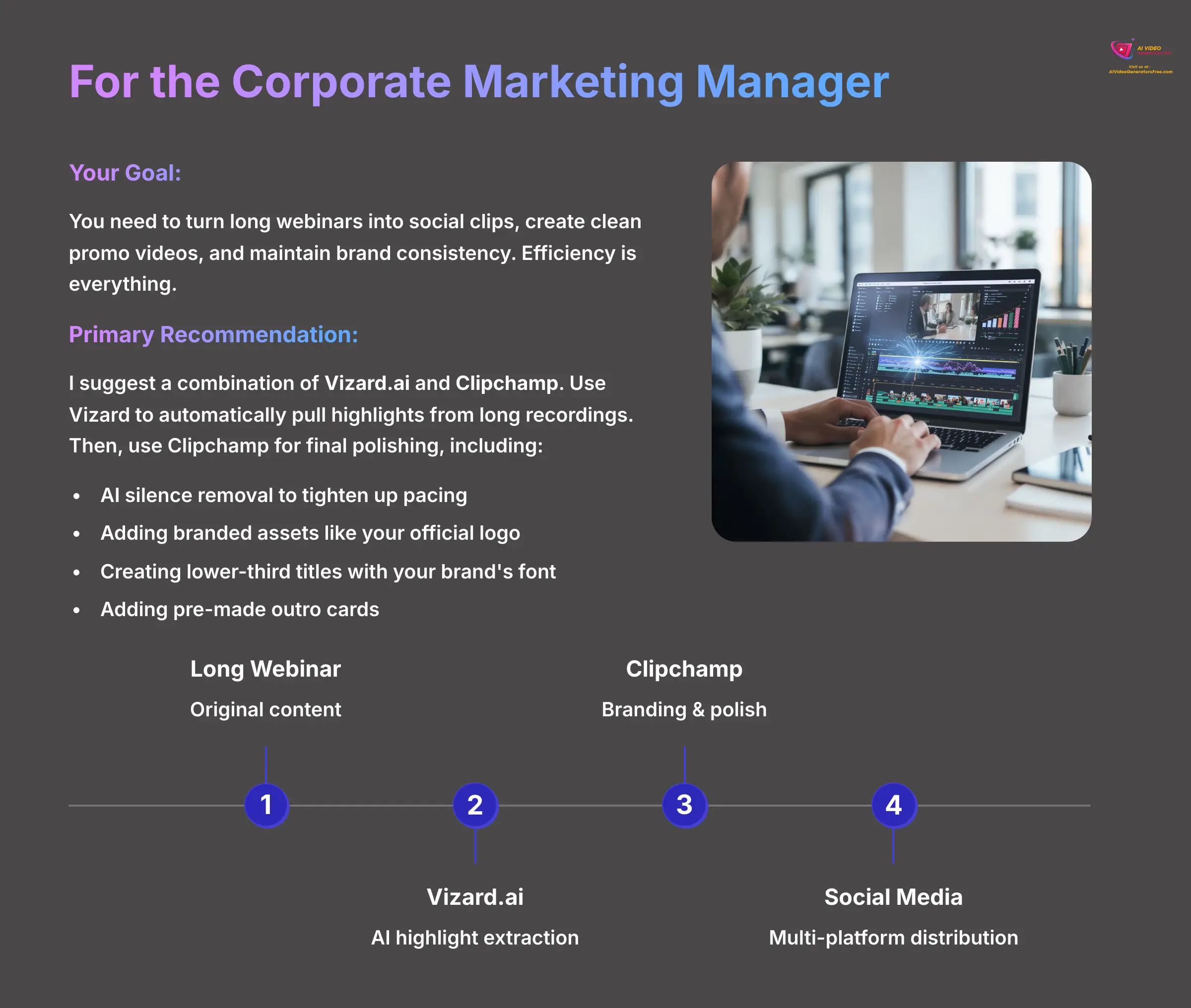

- Your Goal: You need to turn long webinars into social clips, create clean promo videos, and maintain brand consistency. Efficiency is everything.
- Primary Recommendation: I suggest a combination of Vizard.ai and Clipchamp. Use Vizard to automatically pull highlights from long recordings. Then, use Clipchamp for final polishing. This includes tasks like using its AI silence removal to tighten up pacing and adding your company's branded assets—like your official logo, lower-third titles with your brand's font, and a pre-made outro card.
For the Independent Filmmaker
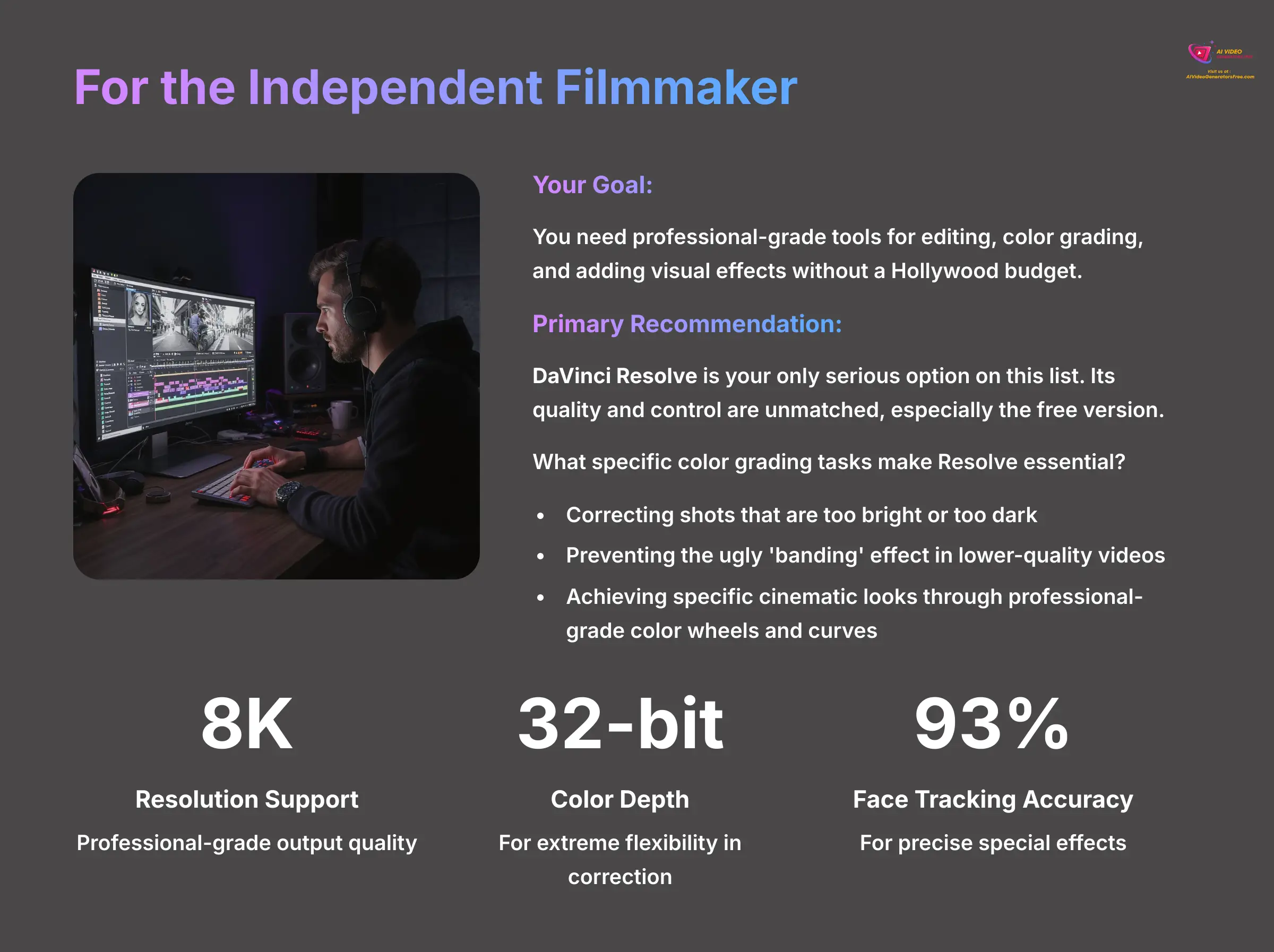

- Your Goal: You need professional-grade tools for editing, color grading, and adding some visual effects without a Hollywood budget.
- Primary Recommendation: DaVinci Resolve is your only serious option on this list. Its quality and control are unmatched, especially the free version. What specific color grading tasks make Resolve essential? Think of situations like correcting shots that are too bright or too dark, preventing that ugly ‘banding' effect you see in lower-quality videos, or achieving specific cinematic looks through professional-grade color wheels and curves.
For the Full-Time TikTok Creator
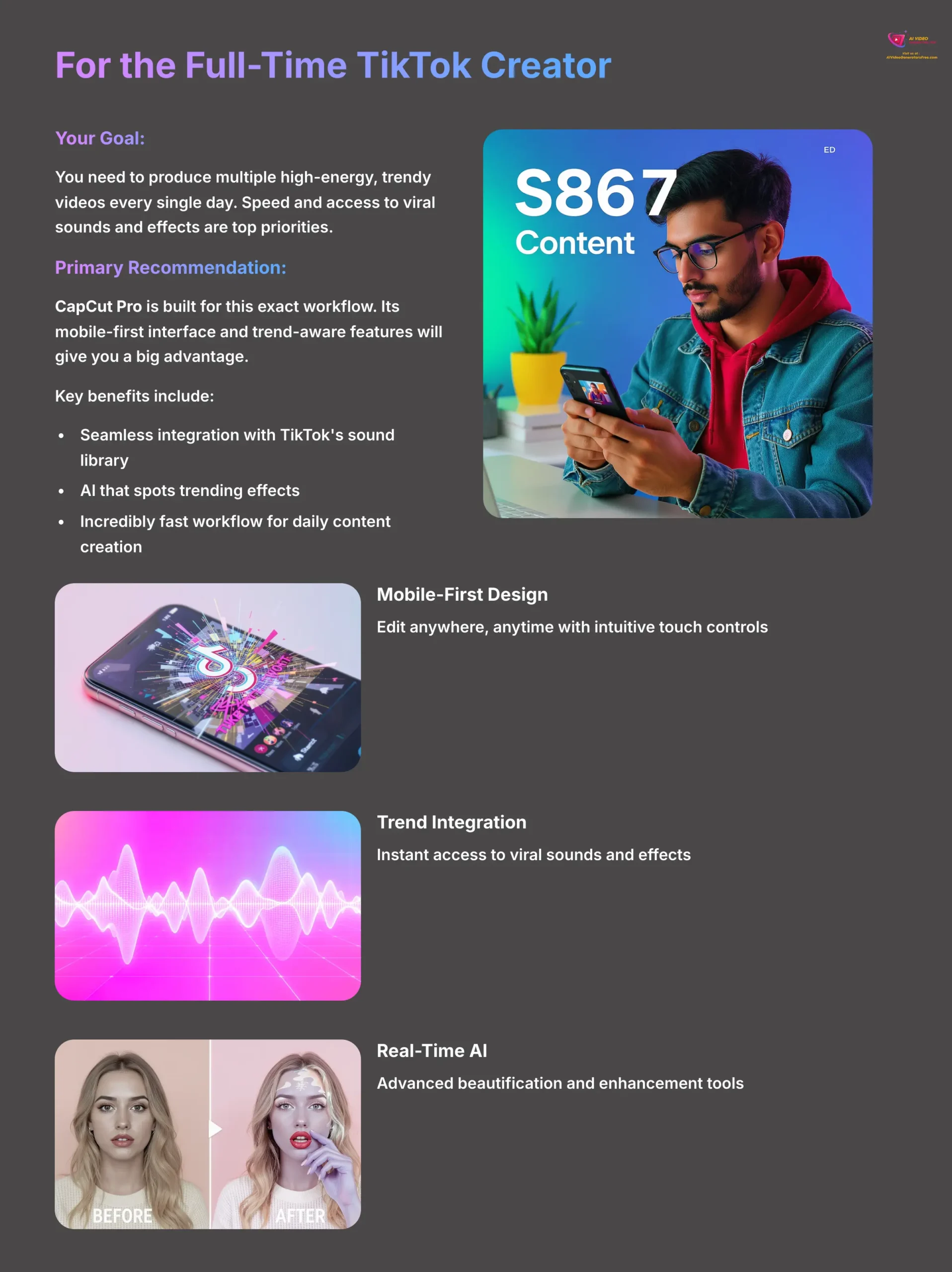

- Your Goal: You need to produce multiple high-energy, trendy videos every single day. Speed and access to viral sounds and effects are top priorities.
- Primary Recommendation: CapCut Pro is built for this exact workflow. Its mobile-first interface and trend-aware features will give you a big advantage. The seamless integration with TikTok's sound library and AI that spots trending effects makes it incredibly fast for daily content creation.
Head-to-Head: A Feature-by-Feature Comparison
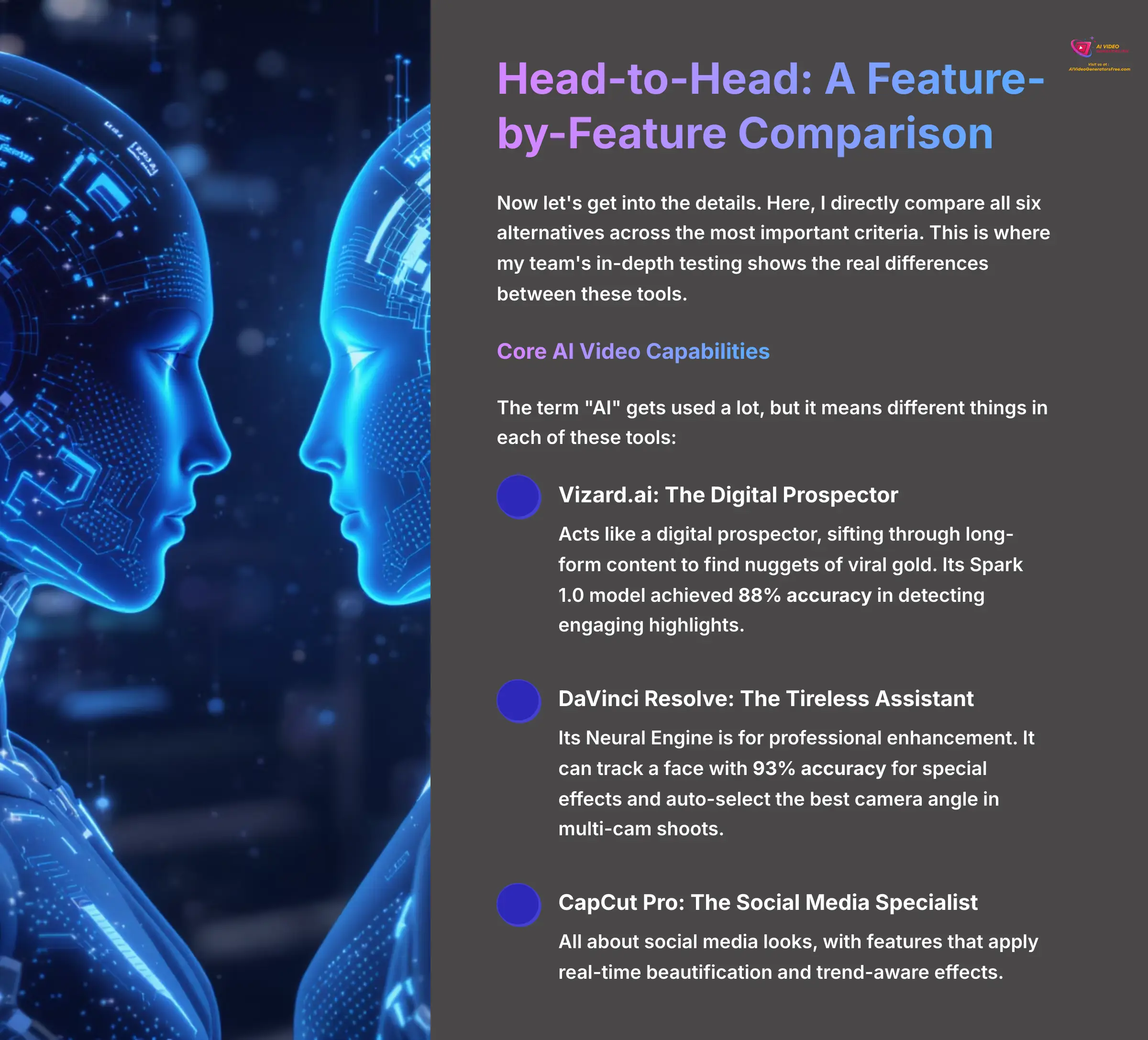

Now let's get into the details. Here, I directly compare all six alternatives across the most important criteria. This is where my team's in-depth testing shows the real differences between these tools.
Core AI Video Capabilities
The term “AI” gets used a lot, but it means different things in each of these tools. Vizard.ai, for example, acts like a digital prospector, sifting through your long-form content to find nuggets of viral gold. Its whole purpose is AI-driven repurposing. In my testing, its Spark 1.0 model achieved 88% accuracy in detecting engaging highlights.
DaVinci Resolve's AI Neural Engine is for professional enhancement. Think of it as a tireless assistant editor. It can track a face with 93% accuracy for special effects, meaning you don't have to manually mask frames. It can even auto-select the best camera angle in a multi-cam shoot, saving hours in post-production.
CapCut Pro's AI is all about social media looks, with features that apply real-time beautification. Clipchamp and VEED.io use AI for practical tasks like removing silent gaps or adding subtitles, making them fantastic for cleaning up presentations and interviews. InVideo's template-based AI differs from VEED.io's utility-focused AI by primarily assembling videos from templates based on a script, while VEED.io's AI focuses more on enhancing existing footage.
Audio Editing Capabilities: Beyond the Basics
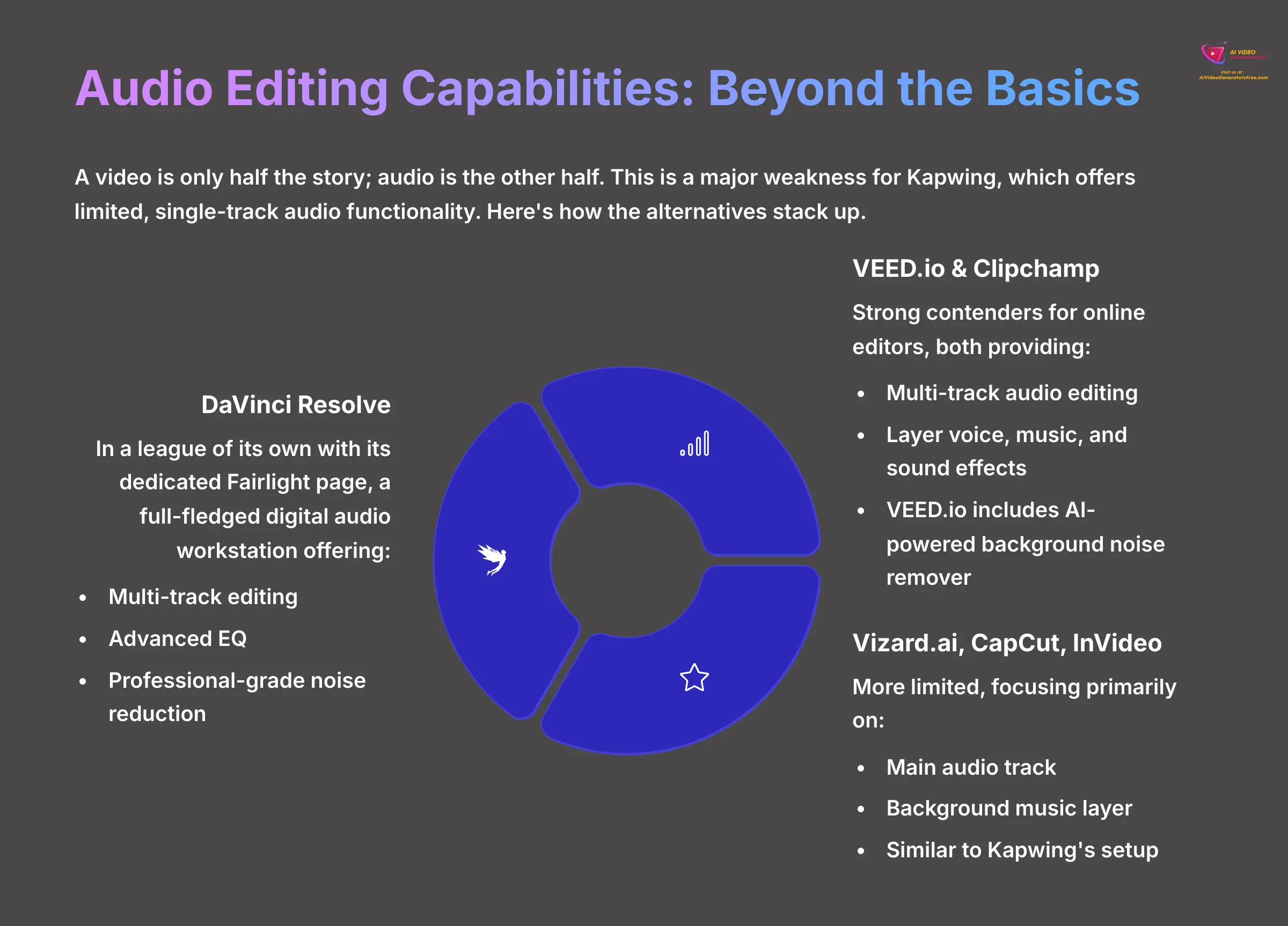

A video is only half the story; audio is the other half. This is a major weakness for Kapwing, which offers limited, single-track audio functionality. Here's how the alternatives stack up.
DaVinci Resolve is in a league of its own with its dedicated Fairlight page, a full-fledged digital audio workstation offering multi-track editing, advanced EQ, and professional-grade noise reduction. For online editors, VEED.io and Clipchamp are strong contenders, both providing multi-track audio editing, allowing you to layer voice, music, and sound effects. VEED.io also includes a handy AI-powered background noise remover.
Vizard.ai, CapCut, and InVideo are more limited, focusing primarily on a main audio track with a background music layer, similar to Kapwing's setup.
Output Quality and Performance
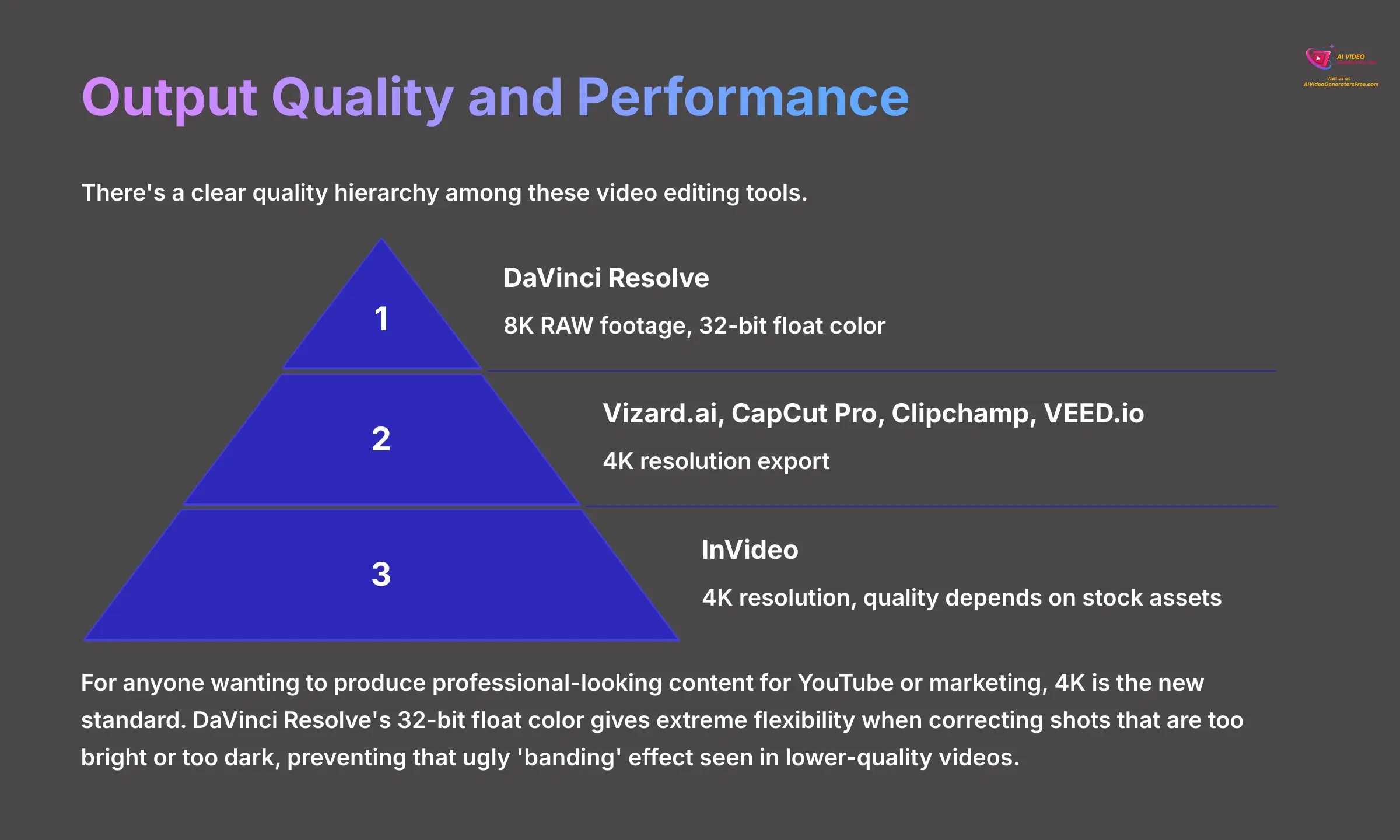

There's a clear quality hierarchy here. DaVinci Resolve is at the absolute top, supporting up to 8K RAW footage. It also uses professional 32-bit float color, which gives you extreme flexibility when correcting shots that are too bright or too dark, preventing that ugly ‘banding' effect you see in lower-quality videos.
In the next tier, you have Vizard.ai, CapCut Pro, Clipchamp, and VEED.io. All of these tools export in 4K resolution, which is a huge step up from standard output. For anyone wanting to produce professional-looking content for YouTube or marketing, 4K is the new standard. InVideo also supports exporting videos in 4K resolution, with quality that depends on the stock assets used in its templates.
User Experience and Learning Curve
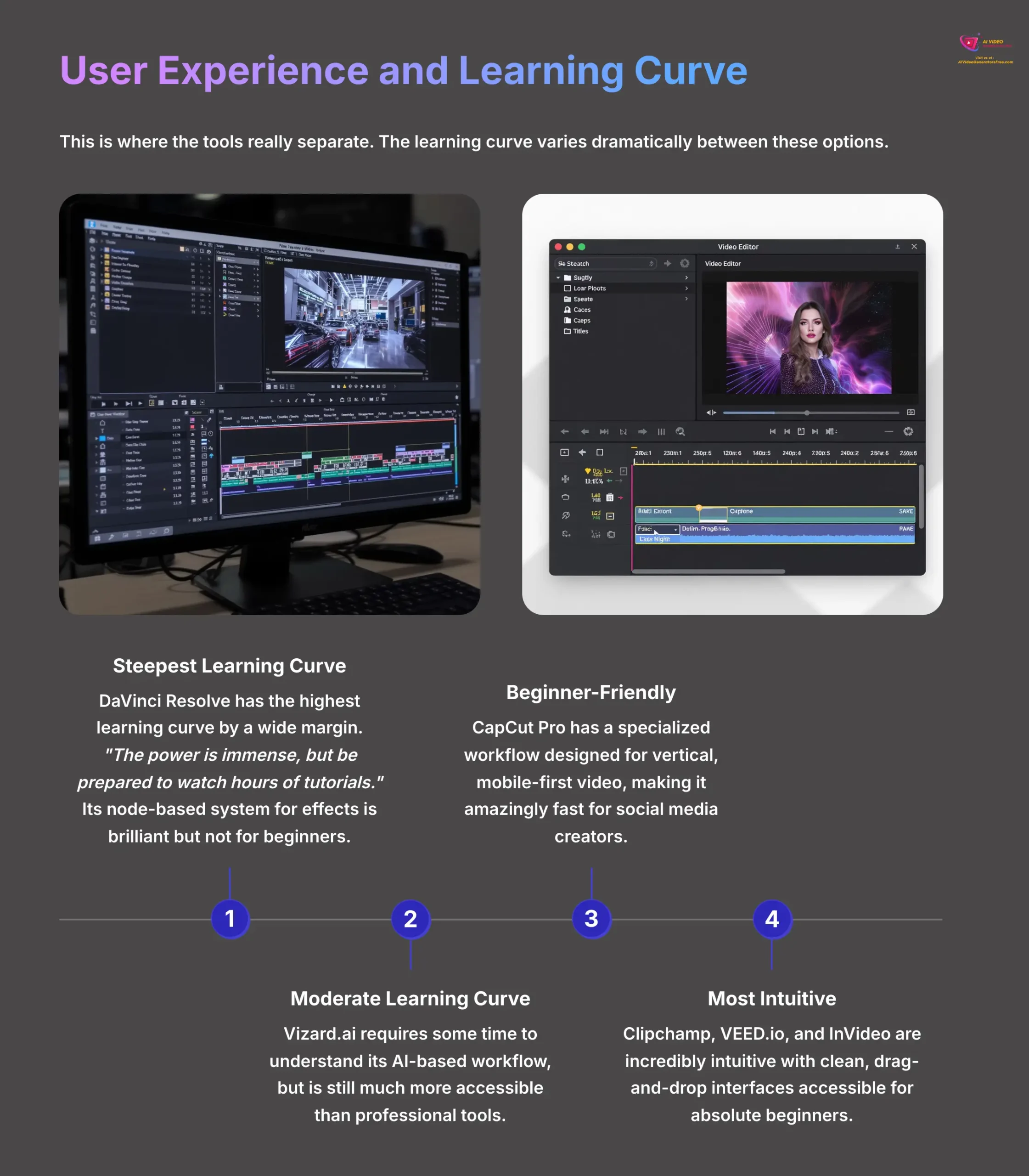

This is where the tools really separate. DaVinci Resolve has the highest learning curve by a wide margin. A comment I saw on a tech forum sums it up perfectly: “The power is immense, but be prepared to watch hours of tutorials.” Its node-based system for effects is brilliant but not for beginners. Using it for a simple trim is like using a sledgehammer to crack a nut.
On the other end of the spectrum, Clipchamp, VEED.io, and InVideo are incredibly intuitive. Their clean, drag-and-drop interfaces make them accessible for absolute beginners. Both VEED.io and InVideo offer streamlined onboarding processes that get users creating within minutes. CapCut Pro has a specialized workflow designed for vertical, mobile-first video, making it amazingly fast for social media creators.
Pricing Structure and Overall Value
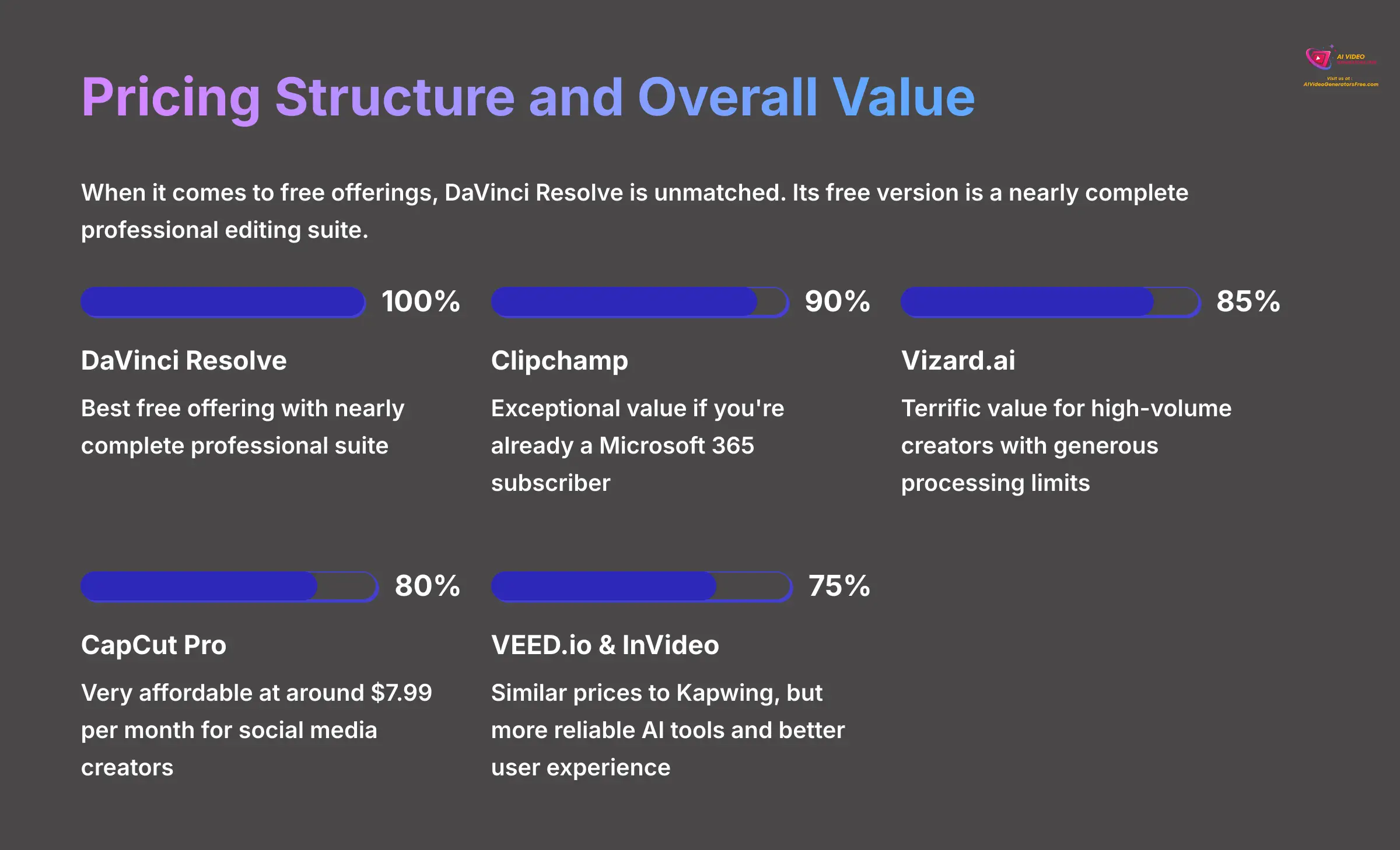

When it comes to free offerings, DaVinci Resolve is unmatched. Its free version is a nearly complete professional editing suite. If you're willing to learn it, the value is incredible. For those who need a subscription, Clipchamp offers exceptional value if you're already a Microsoft 365 subscriber.
My analysis found that Vizard.ai provides terrific value for high-volume creators. CapCut Pro is also very affordable at around $7.99 per month. VEED.io and InVideo have prices similar to Kapwing, but our analysis indicates their more reliable AI tools and better user experience offer a stronger overall value.
In-Depth Tool Reviews
For those who have narrowed their choices, here is a deeper look at the top contenders. I've structured these reviews to give you a clear, side-by-side picture of what each tool does best.
Vizard.ai: The AI Repurposing Specialist
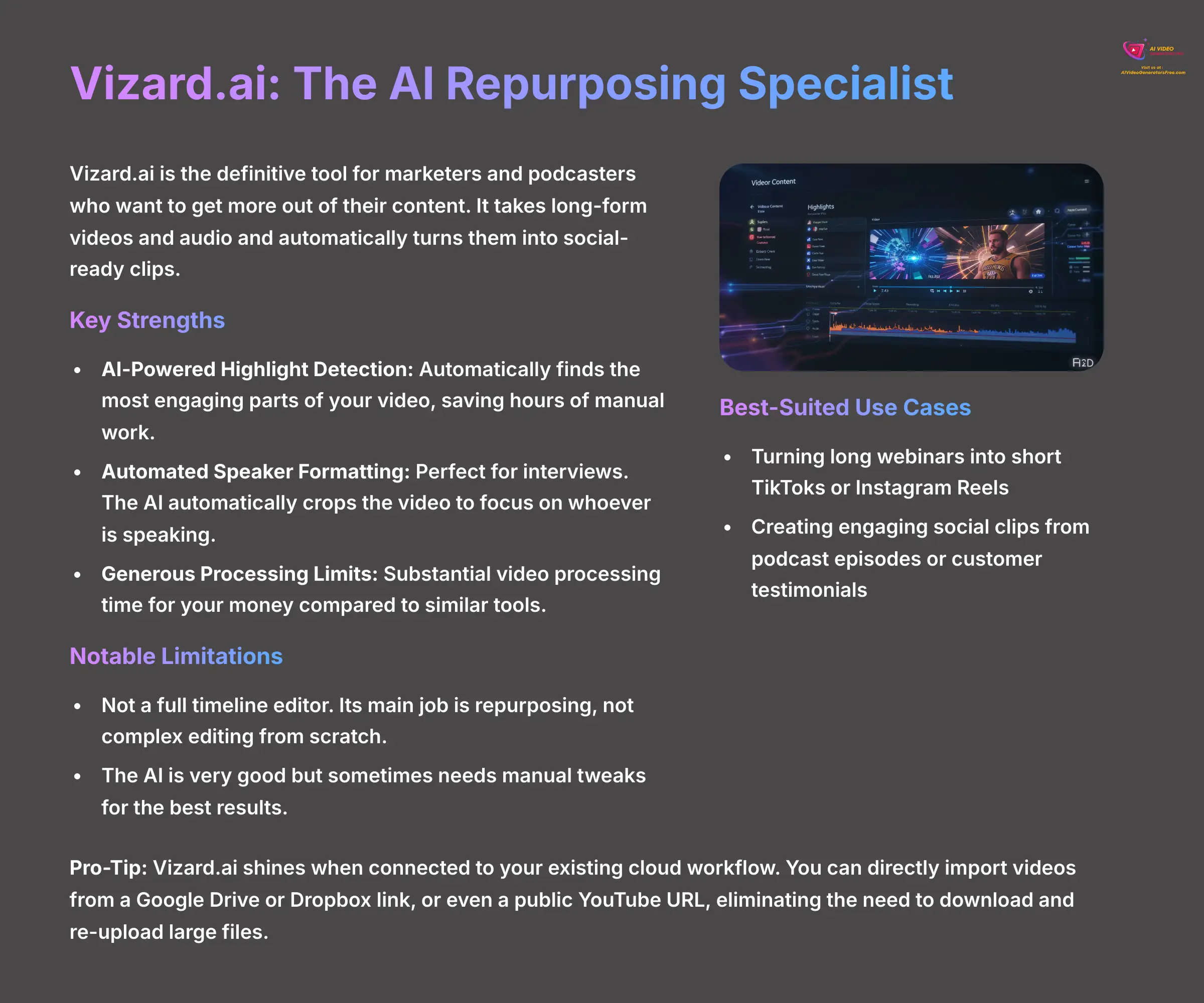

Vizard.ai is the definitive tool for marketers and podcasters who want to get more out of their content. It takes long-form videos and audio and automatically turns them into social-ready clips.
Key Strengths
- AI-Powered Highlight Detection: This feature is a game-changer. It automatically finds the most engaging parts of your video, which saves hours of manual work.
- Automated Speaker Formatting: It is perfect for interviews. The AI automatically crops the video to focus on whoever is speaking.
- Generous Processing Limits: You get substantial video processing time for your money when compared to similar tools.
Notable Limitations
- It is not a full timeline editor. Its main job is repurposing, not complex editing from scratch.
- The AI is very good but sometimes needs manual tweaks for the best results.
Best-Suited Use Cases
- Turning long webinars into short TikToks or Instagram Reels.
- Creating engaging social clips from podcast episodes or customer testimonials.
Pro-Tip for Workflow Integration
Vizard.ai shines when connected to your existing cloud workflow. You can directly import videos from a Google Drive or Dropbox link, or even a public YouTube URL. This eliminates the need to download and re-upload large webinar or podcast files, saving significant time and bandwidth.
Important Warnings & Notes
This is a repurposing tool first and foremost. Do not expect it to have all the creative effects or timeline control of a general-purpose editor. It does one job, but it does it exceptionally well.
DaVinci Resolve: The Hollywood-Grade Professional Suite
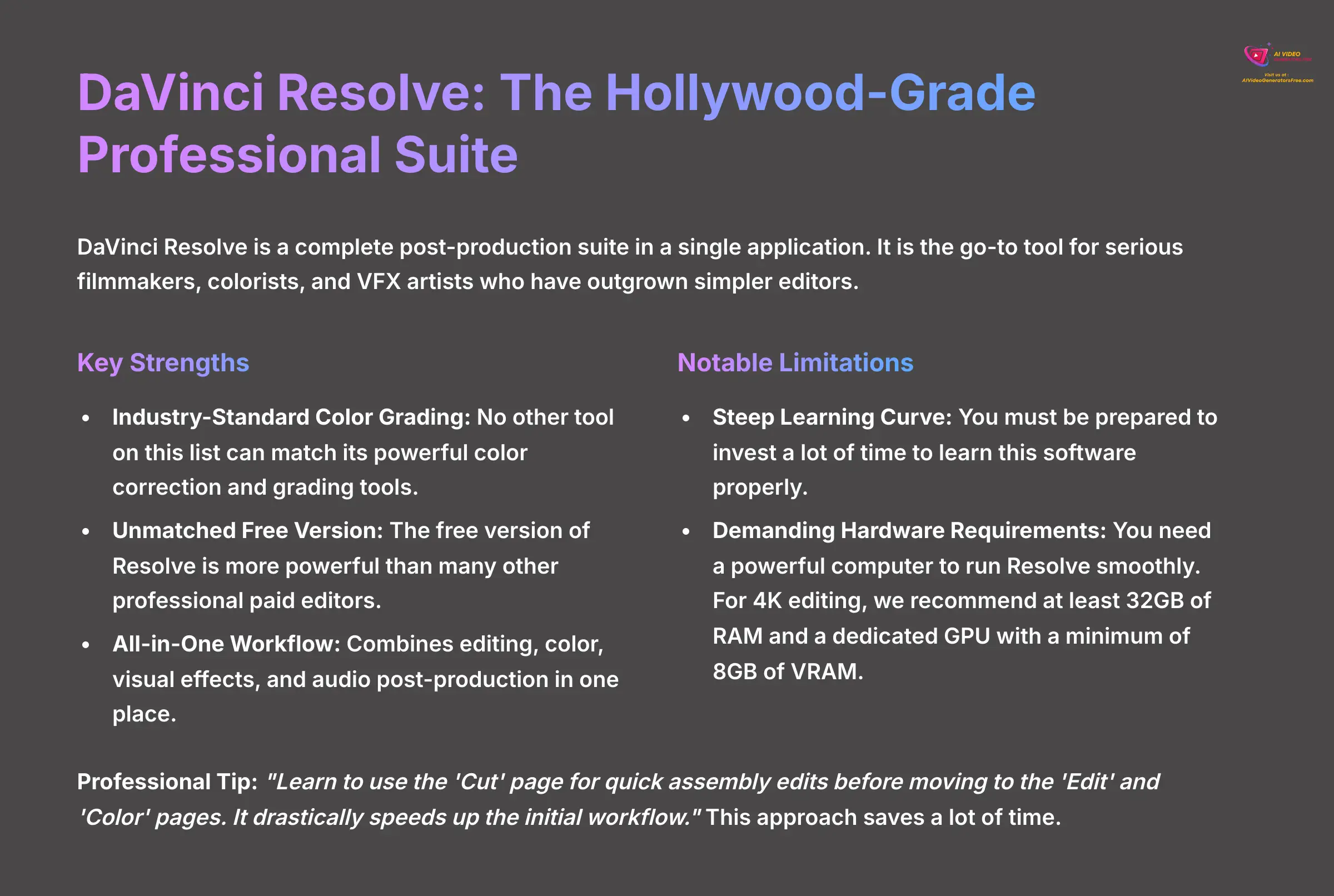

DaVinci Resolve is a complete post-production suite in a single application. It is the go-to tool for serious filmmakers, colorists, and VFX artists who have outgrown simpler editors.
Key Strengths
- Industry-Standard Color Grading: No other tool on this list can match its powerful color correction and grading tools.
- Unmatched Free Version: The free version of Resolve is more powerful than many other professional paid editors.
- All-in-One Workflow: It combines editing, color, visual effects, and audio post-production in one place.
Notable Limitations
- Steep Learning Curve: You must be prepared to invest a lot of time to learn this software properly.
- Demanding Hardware Requirements: You need a powerful computer to run Resolve smoothly. For 4K editing, we recommend at least 32GB of RAM and a dedicated GPU with a minimum of 8GB of VRAM to avoid performance bottlenecks, especially when using the Fusion (VFX) or Color pages.
Best-Suited Use Cases
- Editing short films or professional video projects.
- Performing advanced color grading to achieve a specific cinematic look.
- Adding professional visual effects to your videos.
Professional Tips & Techniques
Here's a great tip I learned: “Learn to use the ‘Cut' page for quick assembly edits before moving to the ‘Edit' and ‘Color' pages. It drastically speeds up the initial workflow.” This approach saves a lot of time.
CapCut Pro: The Social Media Powerhouse
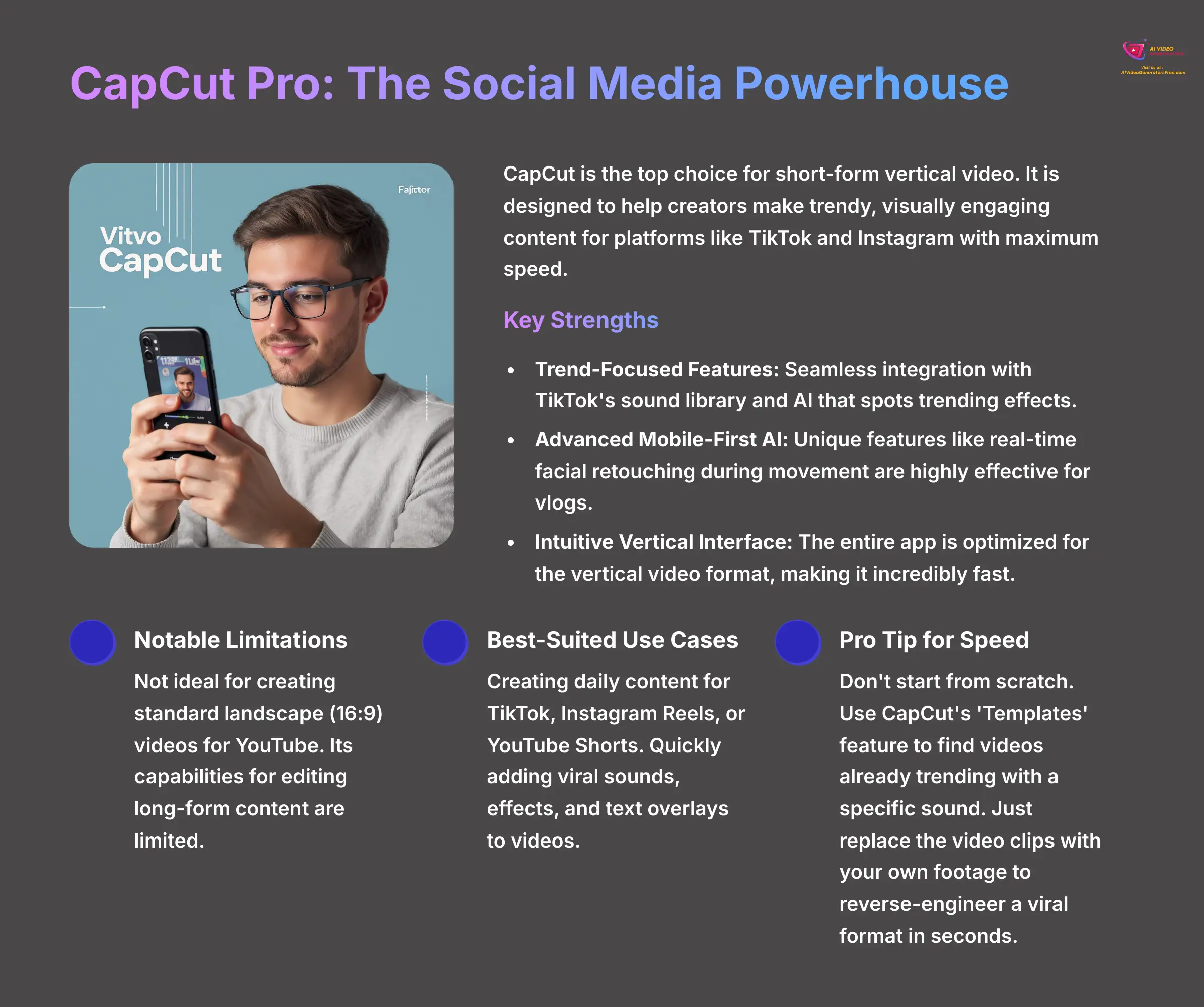

CapCut is the top choice for short-form vertical video. It is designed to help creators make trendy, visually engaging content for platforms like TikTok and Instagram with maximum speed.
Key Strengths
- Trend-Focused Features: It has seamless integration with TikTok's sound library and AI that spots trending effects.
- Advanced Mobile-First AI: Unique features like real-time facial retouching during movement are highly effective for vlogs.
- Intuitive Vertical Interface: The entire app is optimized for the vertical video format, making it incredibly fast.
Notable Limitations
- It is not ideal for creating standard landscape (16:9) videos for YouTube.
- Its capabilities for editing long-form content are limited.
Best-Suited Use Cases
- Creating daily content for TikTok, Instagram Reels, or YouTube Shorts.
- Quickly adding viral sounds, effects, and text overlays to videos.
Pro Tip for Speed
Don't start from scratch. Use CapCut's ‘Templates' feature to find videos already trending with a specific sound. Just replace the video clips with your own footage. This reverse-engineers a viral format in seconds, saving you from having to recreate effects manually.
Important Warnings & Notes
Users report that while the free version is great, the Pro subscription is essential for anyone wanting to remove watermarks and use commercial music licenses. This is an important consideration for business users.
Clipchamp: The Corporate-Friendly Editor
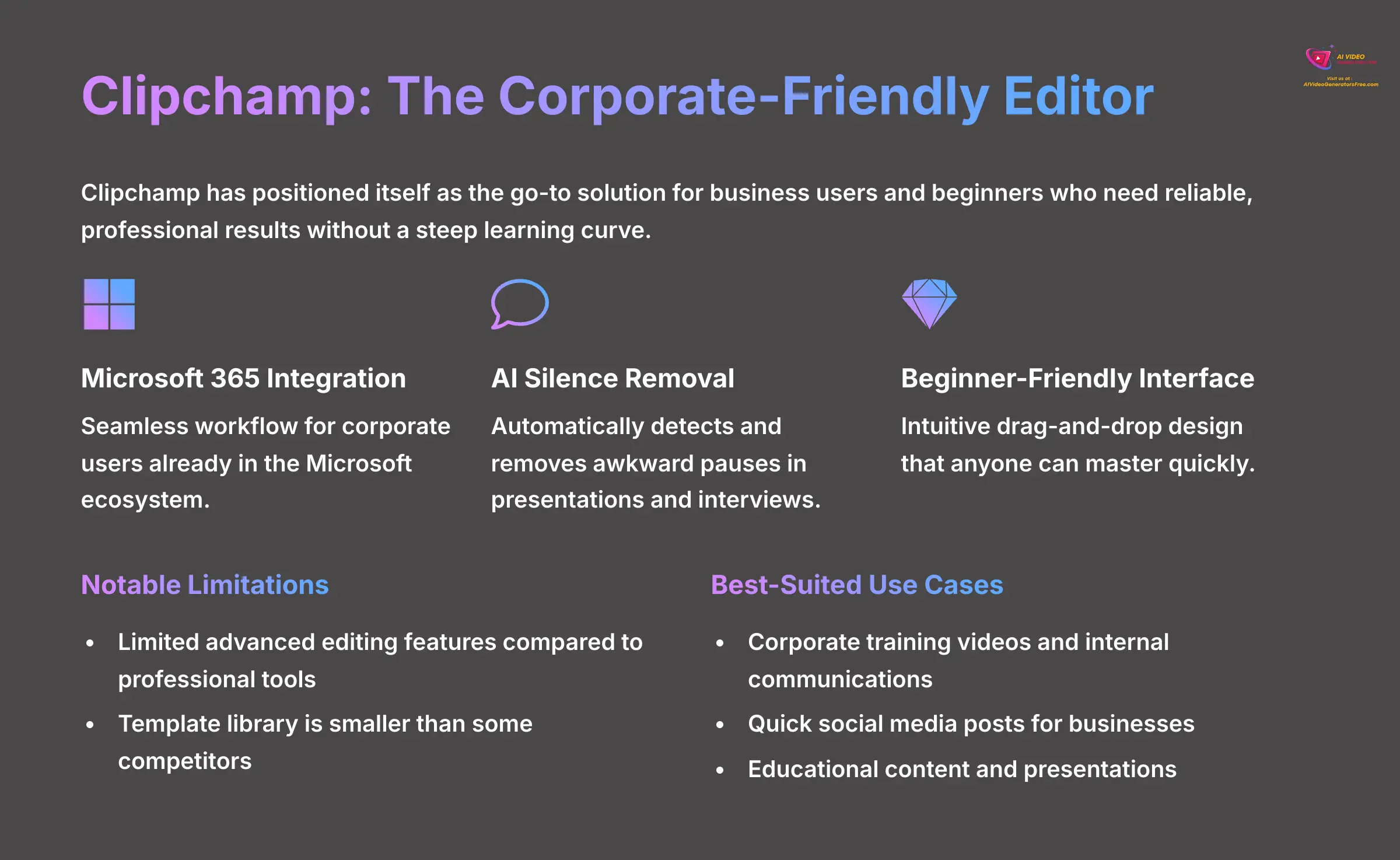

Clipchamp has positioned itself as the go-to solution for business users and beginners who need reliable, professional results without a steep learning curve.
Key Strengths
- Microsoft 365 Integration: Seamless workflow for corporate users already in the Microsoft ecosystem.
- AI Silence Removal: Automatically detects and removes awkward pauses in presentations and interviews.
- Beginner-Friendly Interface: Intuitive drag-and-drop design that anyone can master quickly.
Notable Limitations
- Limited advanced editing features compared to professional tools.
- Template library is smaller than some competitors.
Best-Suited Use Cases
- Corporate training videos and internal communications.
- Quick social media posts for businesses.
- Educational content and presentations.
Expert Insights
Clipchamp excels in corporate environments where consistency and ease of use matter more than cutting-edge features. Its AI silence detection is particularly valuable for cleaning up recorded meetings and webinars.
VEED.io: The All-in-One Online Editor
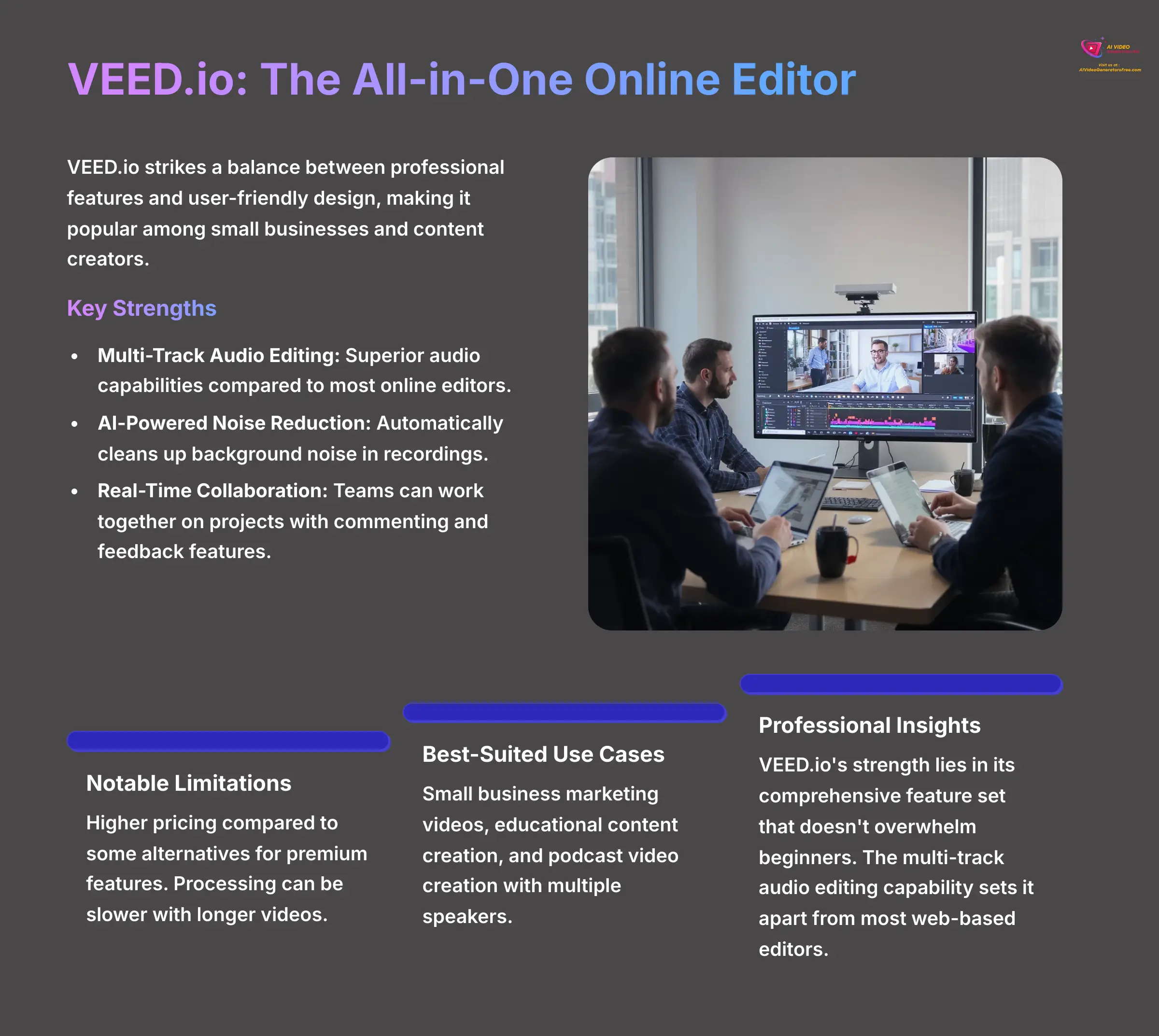

VEED.io strikes a balance between professional features and user-friendly design, making it popular among small businesses and content creators.
Key Strengths
- Multi-Track Audio Editing: Superior audio capabilities compared to most online editors.
- AI-Powered Noise Reduction: Automatically cleans up background noise in recordings.
- Real-Time Collaboration: Teams can work together on projects with commenting and feedback features.
Notable Limitations
- Higher pricing compared to some alternatives for premium features.
- Processing can be slower with longer videos.
Best-Suited Use Cases
- Small business marketing videos.
- Educational content creation.
- Podcast video creation with multiple speakers.
Professional Insights
VEED.io's strength lies in its comprehensive feature set that doesn't overwhelm beginners. The multi-track audio editing capability sets it apart from most web-based editors.
InVideo: The Template-Driven Solution
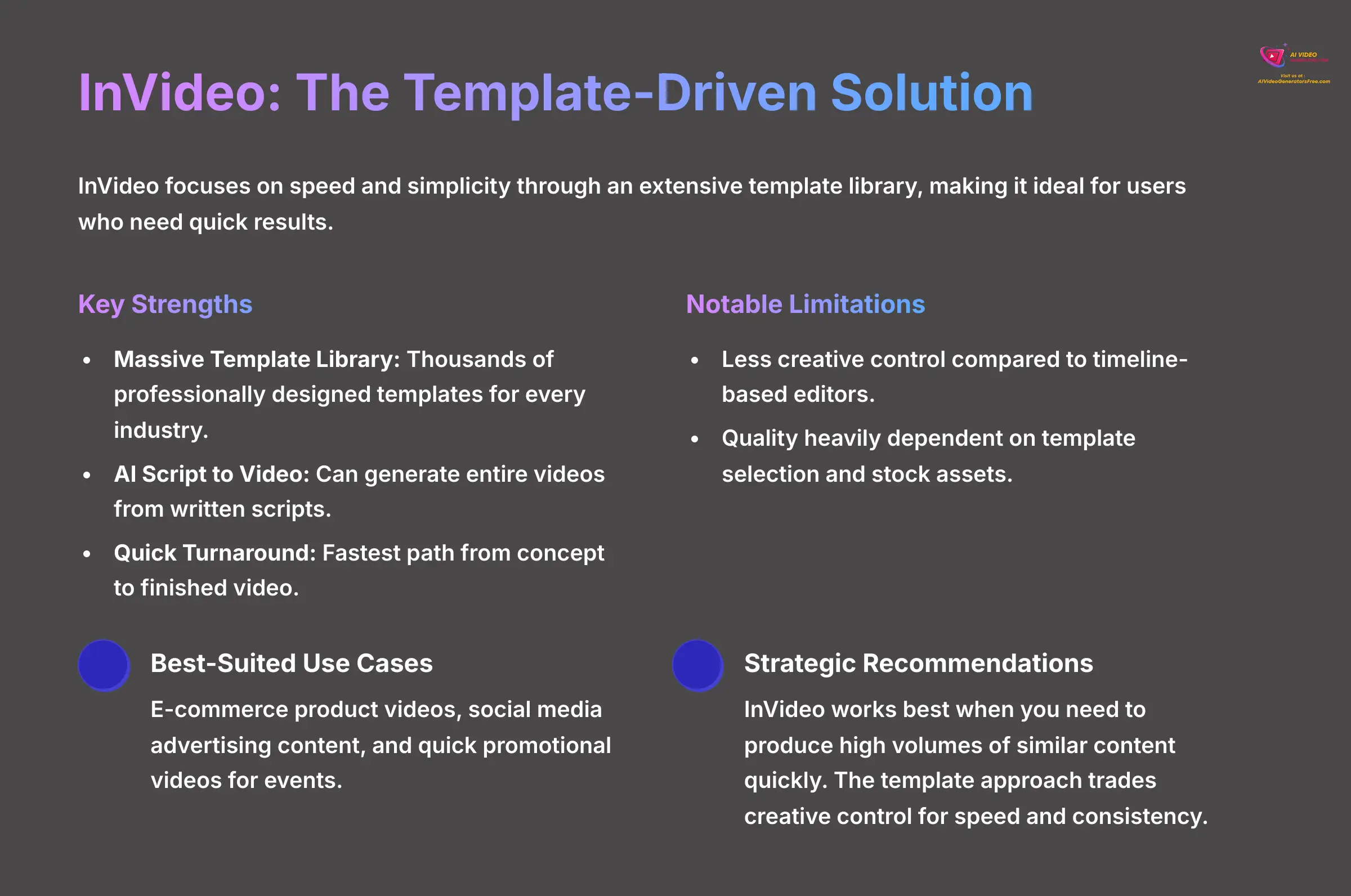

InVideo focuses on speed and simplicity through an extensive template library, making it ideal for users who need quick results.
Key Strengths
- Massive Template Library: Thousands of professionally designed templates for every industry.
- AI Script to Video: Can generate entire videos from written scripts.
- Quick Turnaround: Fastest path from concept to finished video.
Notable Limitations
- Less creative control compared to timeline-based editors.
- Quality heavily dependent on template selection and stock assets.
Best-Suited Use Cases
- E-commerce product videos.
- Social media advertising content.
- Quick promotional videos for events.
Strategic Recommendations
InVideo works best when you need to produce high volumes of similar content quickly. The template approach trades creative control for speed and consistency.
The Ultimate Feature Matrix
To give you the clearest possible comparison, here is a feature matrix. I've included Kapwing as a baseline so you can see exactly where these alternatives offer an upgrade. This table helps you check for the specific features that matter most to you.
| Feature | Vizard.ai | DaVinci Resolve | CapCut Pro | Clipchamp | VEED.io | InVideo | Kapwing |
|---|---|---|---|---|---|---|---|
| Max Resolution (4K+) | ✅ | ✅ | ✅ | ✅ | ✅ | ✅ | ✅ |
| AI Content Repurposing | ✅ | ❌ | ❌ | ❌ | ❌ | ❌ | ❌ |
| AI Subtitle Generation | ✅ | ❌ | ✅ | ✅ | ✅ | ✅ | ✅ |
| AI Silence Removal | ❌ | ❌ | ❌ | ✅ | ❌ | ❌ | ❌ |
| Professional Color Grading | ❌ | ✅ | ❌ | ❌ | ❌ | ❌ | ❌ |
| Template Library | ❌ | ❌ | ✅ | ✅ | ✅ | ✅ | ✅ |
| Real-time Collaboration | ✅ | ✅ | ❌ | ✅ | ✅ | ❌ | ✅ |
| Free Version (No Watermark) | ❌ | ✅ | ❌ | ❌ | ❌ | ❌ | ✅ |
| Multi-track Audio Editing | ❌ | ✅ | ❌ | ✅ | ✅ | ❌ | ❌ |
| AI Voice Cloning / TTS | ❌ | ❌ | ❌ | ✅ | ✅ | ✅ | ❌ |
| AI Eye Contact Correction | ❌ | ✅ | ❌ | ❌ | ❌ | ❌ | ❌ |
| Cloud Storage Integration | ✅ | ✅ | ❌ | ✅ | ❌ | ❌ | ❌ |
Disclaimer: The information about alternatives presented in this article reflects our thorough analysis as of 2025. Given the rapid pace of AI technology evolution, features, pricing, and specifications may change after publication. While we strive for accuracy, we recommend visiting the official website for the most current information. Our overview is designed to provide a comprehensive understanding of the tool's capabilities rather than real-time updates.
Final Verdict: Which Kapwing Alternative Should You Choose?


The “best” tool really is the one that solves your biggest problem. After all my testing, the choice becomes clear once you identify your main goal.
If you need to work faster and smarter with your existing content, Vizard.ai is the clear winner. Its approach to content repurposing saves a huge amount of time. If you've hit a quality ceiling and demand professional control, investing the time to learn DaVinci Resolve will benefit you for years. Its free version alone is a massive upgrade.
For anyone who needs to dominate social media, CapCut Pro has the specialized, trend-aware tools that general editors just don't offer. Finally, if you just want a more reliable and user-friendly online editor with better AI and higher resolution than Kapwing, VEED.io and Clipchamp are your strongest options.
The key is to stop looking for one ‘perfect' editor and instead pick the specialized tool that solves your biggest bottleneck. Whether you need Vizard.ai's efficiency, Resolve's quality, or CapCut's speed, the right upgrade is on this list. Choose the one that fits your workflow, and you won't look back.


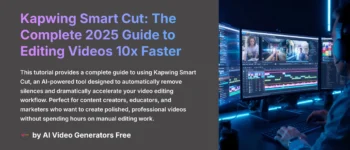
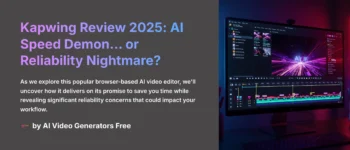
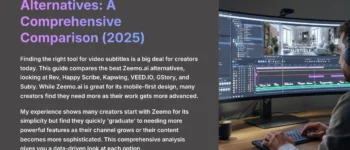



Leave a Reply